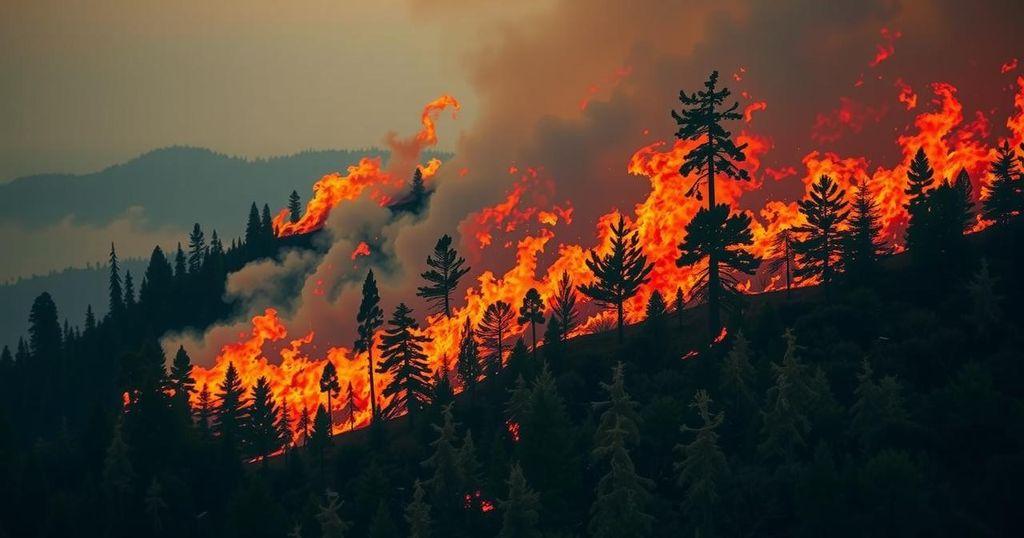Climate Change Fuels Increase in Global Wildfires and Associated Health Risks

Research indicates that climate change has led to a global increase in wildfires, with smoke-related deaths rising significantly from the 1960s to the 2010s. Studies show while some regions have seen a decrease in fire incidents due to human activity, others, especially in North America and Siberia, are experiencing more fires due to climate conditions. Climate change now contributes significantly to wildfire occurrences and smoke-related mortalities, necessitating urgent action for emission reductions and fire management strategies.
Recent research has established a direct correlation between climate change and the rising frequency and severity of wildfires globally, alongside a notable increase in smoke-related mortality over the decades. Two comprehensive studies conducted by teams from Dalhousie University, Belgium, the United Kingdom, and Japan analyzed wildfire dynamics and their health implications, revealing a dramatic increase in fatalities due to wildfire smoke — from an estimated fewer than 669 deaths annually in the 1960s to a staggering 12,566 deaths per year by the 2010s. One study featured in the journal Nature Climate Change utilized predictive wildfire models that incorporated the influences of climate change versus those that did not, indicating a significant uptick in wildfire events and intensity, particularly in vulnerable ecosystems such as the African savannas, Australia, and Siberia. Interestingly, the research highlights marked regional discrepancies in wildfire trends. For instance, Africa, which constitutes around 70 percent of the global burnt area, has seen a decline in wildfires largely attributed to increased human activity and land fragmentation that impedes fire spread. In stark contrast, regions like California and Siberia have experienced an uptick in fire incidents, driven by prolonged droughts and elevated temperatures linked to climate change. Dr. Sian Kou-Giesbrecht, an associate professor at Dalhousie University and a co-author of the studies, emphasized the significance of these findings: “The study is important because it shows and quantifies the influence of climate change on increasing wildfires worldwide, especially given the impacts of wildfire on society and its feedback to climate change.” The research teams employed various models to factor in climate variables, vegetation, and population density. They underscored the limitations of human interventions, such as fire suppression and landscape management, stating their effectiveness diminishes significantly in the face of extreme weather situations. Dr. Seppe Lampe, a climate scientist at Vrije Universiteit Brussel, remarked: “What is striking is that in periods with low to moderate numbers of fires, direct human interventions have a large effect. However, in periods with many fires, the effect of climate change dominates, meaning that in these cases we lose control.” The models demonstrated that from 2003 to 2019, climate change contributed to a nearly 16 percent increase in the global burnt area and augmented the likelihood of monthly occurrences of above-average burned area by 22 percent. Central Australia experienced the most significant rise in burned area attributable to climate change. The importance of implementing stringent greenhouse gas emission reductions, along with effective landscape and fire management strategies, was emphasized by researchers to mitigate wildfire impacts on human safety and ecosystems. A separate study published concurrently indicated that climate change has caused a tenfold increase in the percentage of wildfire smoke-related deaths over the past fifty years. Researchers from the National Institute for Environmental Studies in Japan attributed a growing proportion of wildfire smoke-induced mortality to climate change, identifying a stark increase from 1-3 percent of fire-related deaths in the 1960s to as high as 28 percent in the 2010s. Areas such as South America, Australia, Europe, and the boreal forests of Asia recorded the highest mortality rates linked to wildfire smoke exposure. Dr. Kou-Giesbrecht noted the complexities involved in attributing wildfire occurrences to climate change but affirmed robust findings from the research projects. She warned that if the current trajectory of climate change persists, both the area of burned land and associated health outcomes are poised to escalate significantly in the coming decades.
The studies’ revelations are set against a backdrop of increasing global attention on climate change and its impact on natural disasters, including wildfires. Over the last few decades, climate change has been recognized as a significant driver of extreme weather, contributing to hotter temperatures, prolonged dry spells, and other conditions conducive to wildfires. As human populations expand and land use changes, the dynamics of fire management and its efficacy have become crucial topics of study in understanding how best to approach and mitigate wildfire risks while protecting public health and safety.
The findings from these studies underscore the urgent need for comprehensive strategies to address wildfires, which are increasingly exacerbated by climate change. It is clear that while human interventions can help manage fires, they cannot entirely offset the effects of a changing climate, particularly in conditions of extreme weather. The increase in wildfire-related mortality highlights the potential public health risks posed by wildfires, urging immediate action to reduce greenhouse gas emissions and implement effective fire management techniques.
Original Source: www.dal.ca






